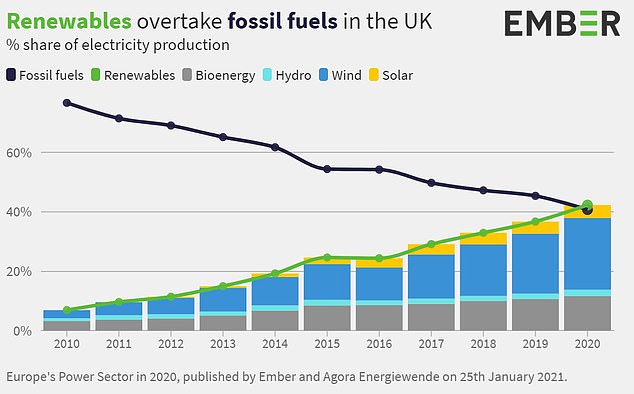It is now official: the UK’s biggest source of energy is renewable!
Data released by Ember, an independent thinktank, shows that for 2020, 42% of the UK’s energy came from renewables (a mix of wind, solar, bioenergy and hydropower), while 41% came from burning gas and coal. Nuclear plants were responsible for the remaining 17% share. This happened in a year where demand for electricity fell sharply as many businesses and factories needed to close to comply with Covid restrictions and power supply into the national grid was regulated. For 2019, the figures were 37% for renewables and 45% for fossils.
Ember attributed the growth majorly to the spurt in number of installed windfarms. They actually contributed a quarter of all the renewable energy, which was double the share in 2015.

Solar and hydro plants made up 4% and 2% respectively of the energy mix, unchanged from the levels in 2019, repeating the stagnant trend for solar in 2018.
Coal power continued its decline, coming in at just 2%. That is expected to drop to zero by 2024, signaling the end of the UK’s long era of use of carbon-emitting fuels in generating electricity. Gas powered facilities power output declined from 41% to 37%, even though it still maintained its lead as the largest single power source.
Ember thinks this trend will continue in the nearest future, with more wind and solar farms being commissioned.

Ember’s Charles Moore said “The coronavirus has accelerated the trend towards renewable energy but we would have expected renewables to overtake fossil fuels by 2021. It has brought forward the trend by only a year or two. Renewables will probably remain above fossil fuels this year, but it’s very dependent on various things like nuclear output and the weather. Even if fossil fuels return this year it will be a narrow lead and a short-lived one.”
This pattern was also noted elsewhere, notably Germany and Spain, where renewable sources also outpaced fossil fuels.
The effect of this dominance by renewable energy sources is already being felt in the dropping levels for carbon intensity (which is the emission rate of a given pollutant, carbon in this case, relative to the intensity of a specific activity, or an industrial production process) of the nation’s power supply. It was 181g/kWh in 2020, significantly down from 248g/kWh in 2019.
Written by D.O. for www.ShargeMe.blog